Matcha
Why Does Matcha Taste Like Seaweed? Find Out!
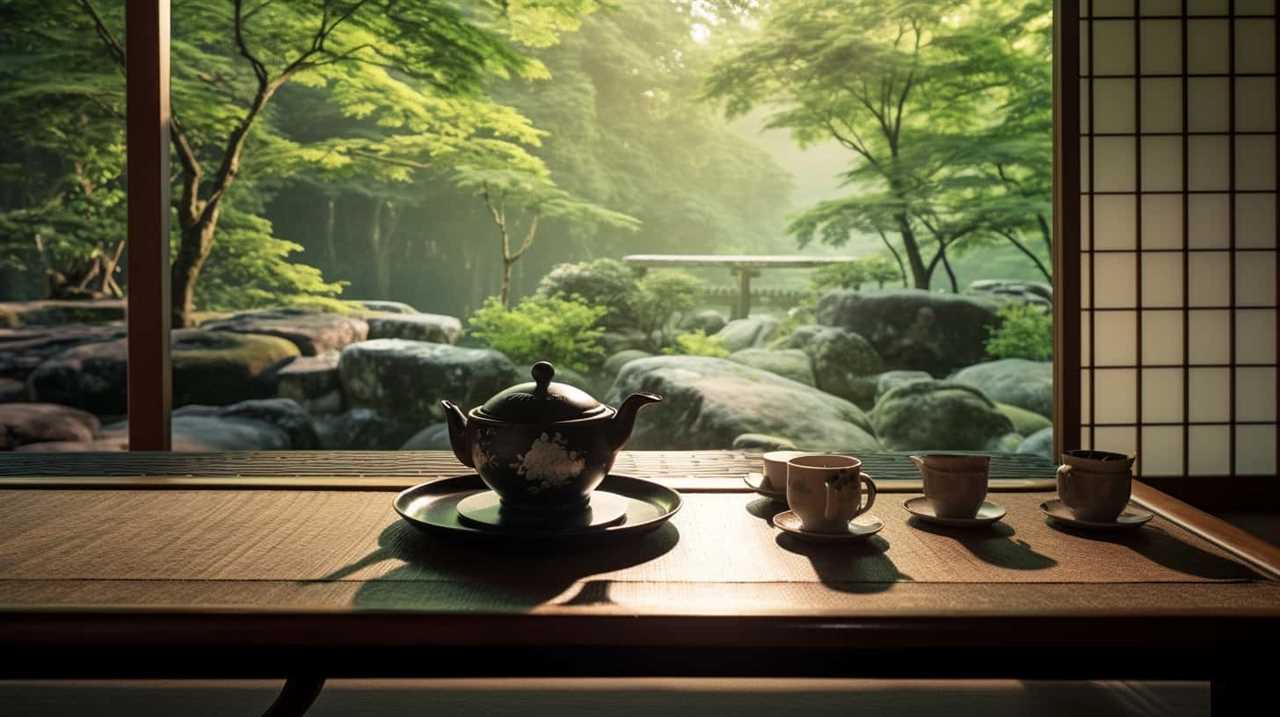
Have you ever wondered what matcha tastes like? Well, brace yourselves, fellow epicureans, for we are about to embark on a flavorful journey.
In this exploration of the culinary arts, we shall delve into the unique taste of matcha, often hailed as the elixir of tranquility.
But here’s the twist: brace your taste buds, for this vibrant green powder may surprise you with a hint of seaweed. Yes, you heard it right, seaweed!
Just like a hidden treasure beneath the ocean waves, matcha’s umami undertones bear a striking resemblance to the briny essence of our sea-dwelling friend.
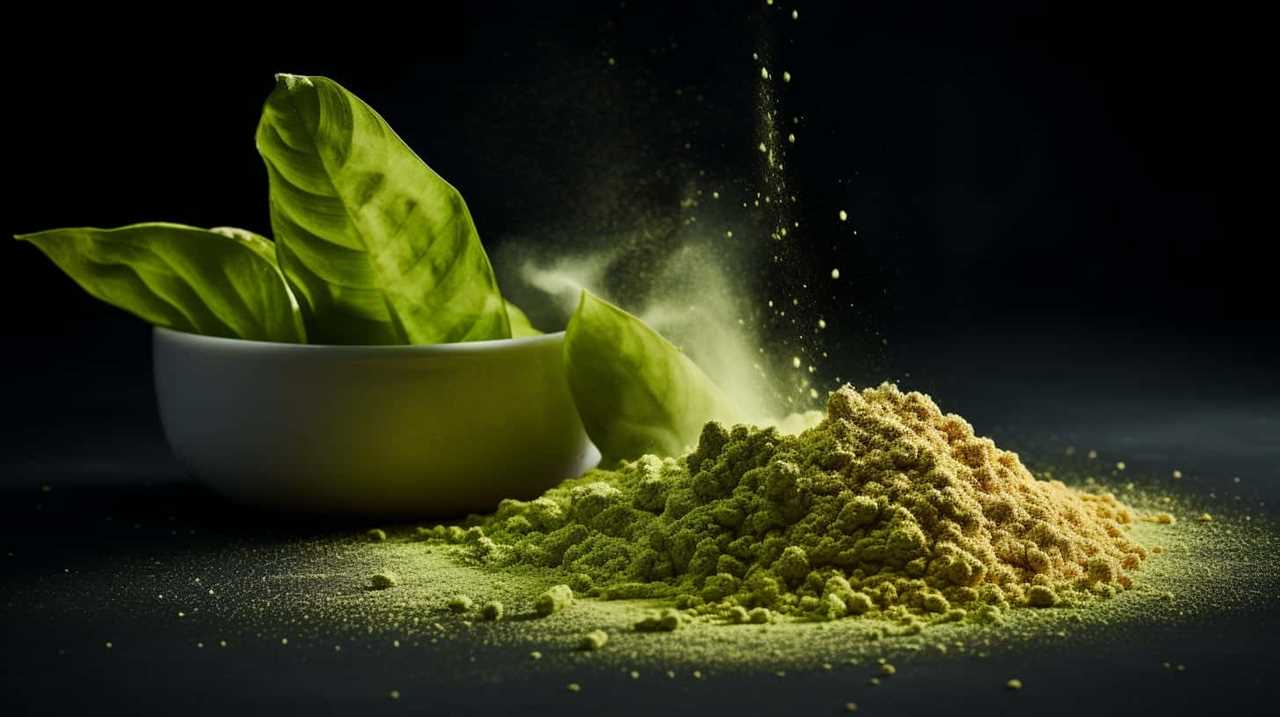
So, join us as we unravel the mysteries of matcha’s taste, and perhaps, discover a newfound appreciation for the wonders of seaweed.
Key Takeaways
- Matcha tea is influenced by factors such as region, leaf quality, and harvesting methods, which contribute to its unique taste.
- Matcha has a flavor profile that includes hints of umami, with some describing it as sweet and grassy, while others find it more vegetal and slightly bitter.
- Matcha’s flavor is earthy and slightly seaweed-like compared to regular tea, and it lingers on the palate due to its full-bodied taste.
- Matcha and seaweed are versatile ingredients used in various culinary dishes, with both having umami taste profiles that enhance the flavors of dishes.
The Origins of Matcha Tea
- We’ll explore the origins of matcha tea and its journey from ancient China to Japan.
Matcha, a vibrant and finely ground green tea powder, has a rich history that dates back over a thousand years. It was first cultivated in China during the Tang Dynasty (618-907 AD) before making its way to Japan in the 12th century.
The taste of matcha is influenced by various factors, such as the region it’s grown in, the quality of the leaves, and the harvesting methods employed. Additionally, the role of processing techniques in matcha’s flavor can’t be overlooked.
The leaves are carefully shade-grown, hand-picked, and steamed to preserve their vibrant green color and unique taste. The meticulous process of grinding the leaves into a fine powder enhances the tea’s smooth, velvety texture and brings out its distinct umami flavor.
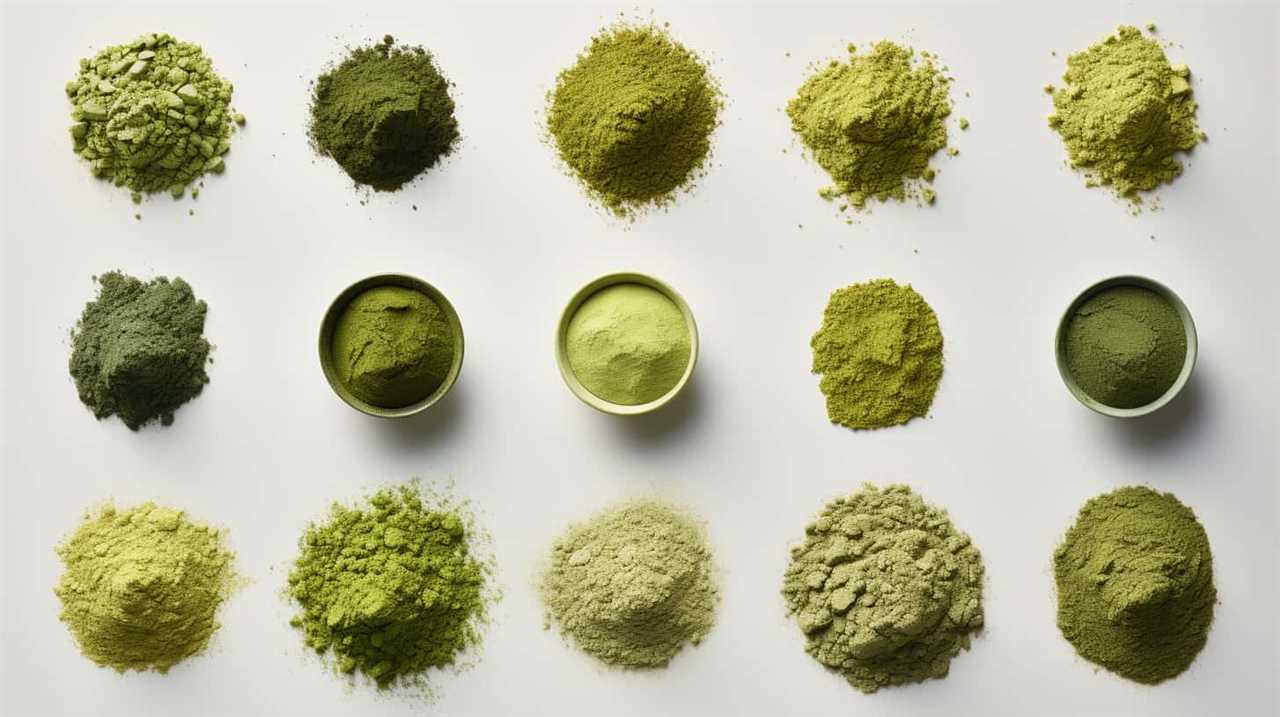
The Flavor Profile of Matcha
When it comes to the flavor profile of matcha, there are two main categories: sweet or savory. Some people describe matcha as having a sweet, grassy taste with hints of umami, while others find it to be more vegetal and slightly bitter.
Compared to regular tea, matcha has a unique flavor that’s often described as earthy and slightly seaweed-like.
Sweet or Savory Matcha
Often, we enjoy the sweet or savory flavors of matcha, which give it a unique and distinct taste. When it comes to exploring flavor combinations, matcha offers a wide range of possibilities. Here are three exciting options to consider:
- Sweet Matcha Latte: Indulge in the creamy and velvety texture of a sweet matcha latte, where the earthy notes of matcha are complemented by the richness of milk and a hint of sweetness.
- Savory Matcha Soup: Experience the umami flavors of matcha in a savory soup, where the grassy undertones of matcha blend harmoniously with ingredients like mushrooms, miso, and tofu.
- Matcha-infused Desserts: Delight your taste buds with matcha-infused desserts like matcha ice cream, matcha cheesecake, or matcha macarons. These treats showcase the vibrant green color and distinct flavor of matcha in a sweet and satisfying way.
As we delve into the world of matcha vs. regular tea, let’s explore how matcha stands out as a unique beverage.

Matcha Vs. Regular Tea?
Now let’s compare the flavor profile of matcha to regular tea. Matcha, with its vibrant green color and unique taste, offers a distinct flavor experience compared to regular tea. While regular tea can vary in taste depending on the type and brewing method, matcha has its own set of characteristics. To better understand the flavor differences, let’s take a look at this table:
| Matcha | Regular Tea |
|---|---|
| Earthy | Floral |
| Umami | Astringent |
| Vegetal | Delicate |
| Full-bodied | Light |
| Slightly sweet | Bitter |
Matcha’s flavor can be described as earthy and slightly sweet, with a hint of umami and vegetal notes. It has a full-bodied taste that lingers on the palate. On the other hand, regular tea often exhibits floral and delicate flavors, with a touch of astringency. These differences in flavor make matcha a unique and enjoyable beverage to explore. Moreover, matcha offers health benefits such as antioxidants and a gentle boost of energy, making it a great alternative to coffee for those seeking a healthier option.
Exploring the Taste of Seaweed
Let’s delve into the taste of seaweed. Seaweed, also known as sea vegetables, offers a unique flavor profile that’s both intriguing and delicious. Here are three aspects of seaweed’s taste that will surely evoke emotions in your palate:
- Umami explosion: Seaweed is renowned for its umami flavor, which adds depth and richness to any dish. Its natural glutamic acids create a savory taste that enhances other ingredients, making them more flavorful and satisfying.
- Nutritional powerhouse: Besides its fantastic taste, seaweed is packed with health benefits. It’s an excellent source of iodine, which supports thyroid function, and is rich in vitamins, minerals, and antioxidants. Incorporating seaweed into your diet can boost your immune system and promote overall wellbeing.
- Earthy and briny notes: Seaweed’s taste is often described as earthy and briny, reminiscent of the sea itself. Its complex flavor profile adds a unique depth and character to dishes, bringing a touch of the ocean to your plate.
Now that we’ve explored the taste of seaweed, let’s transition to the subsequent section where we’ll uncover the surprising similarities between matcha and seaweed.
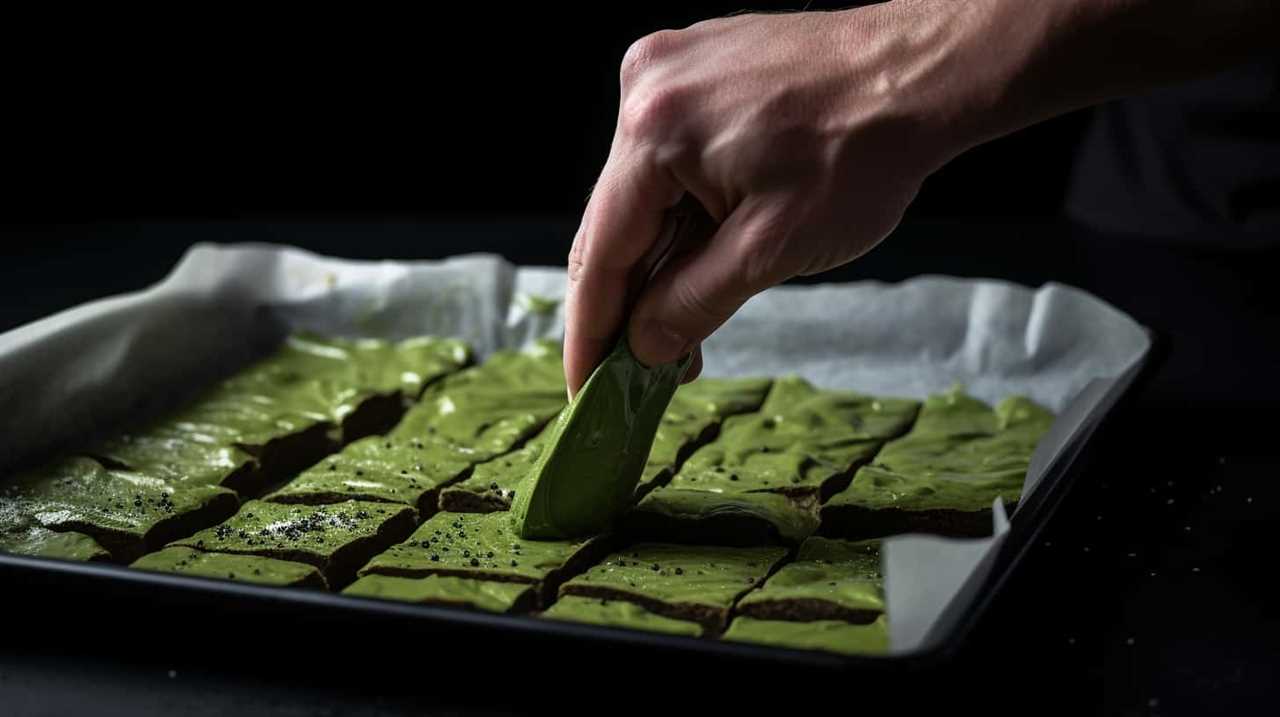
The Similarities Between Matcha and Seaweed
We discovered surprising similarities between matcha and seaweed.
Both matcha and seaweed have been used for centuries in culinary practices around the world. Matcha is a finely ground powder made from green tea leaves, while seaweed is a type of marine algae that’s commonly used in Asian cuisine.
One of the main similarities between matcha and seaweed is their unique flavor profiles. Both have a distinct umami taste that can be described as savory and slightly briny. This flavor adds depth and complexity to dishes, making them more flavorful and satisfying.
Additionally, both matcha and seaweed offer numerous health benefits. They’re both rich in antioxidants and are believed to support overall health and well-being.
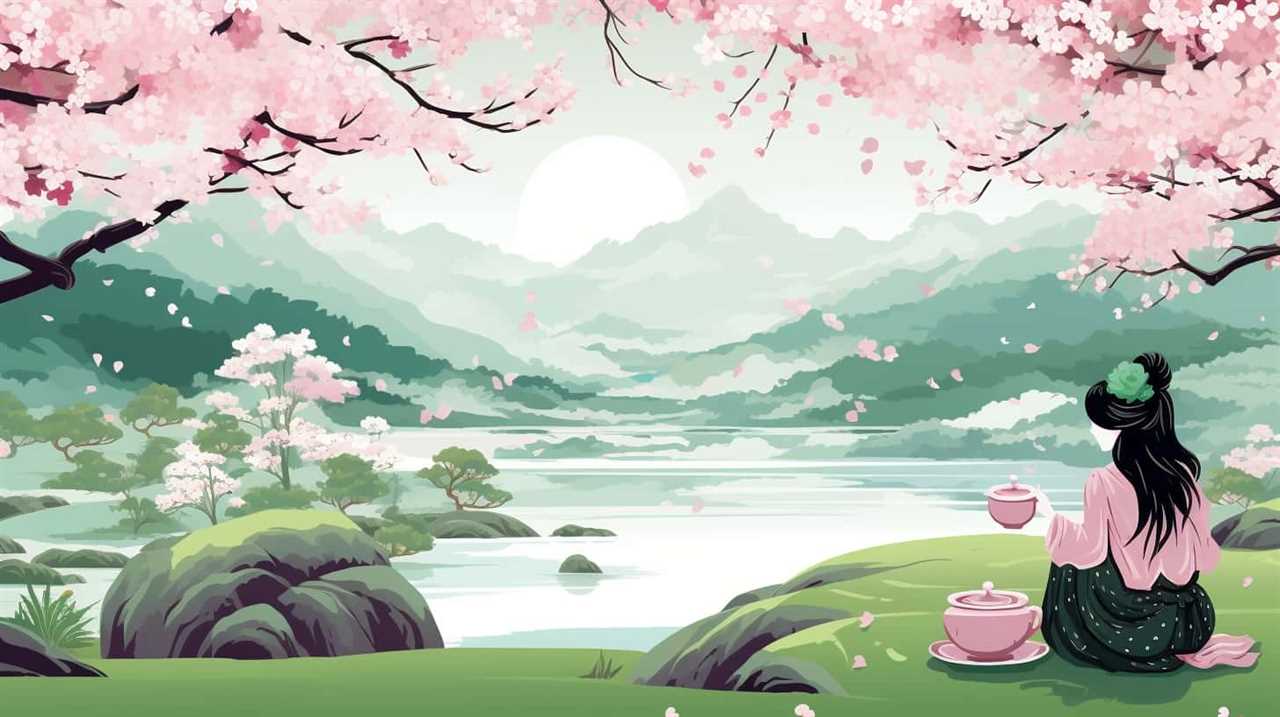
These similarities in culinary uses and health benefits make matcha and seaweed versatile ingredients that can enhance a wide range of dishes. Understanding these similarities is crucial in uncovering the factors that influence matcha’s taste.
Factors Influencing Matcha’s Taste
When it comes to the taste of matcha, there are two main factors that play a significant role: growing conditions and processing techniques.
The conditions in which the tea leaves are grown, including factors like soil composition, climate, and altitude, can greatly impact the flavor profile of matcha.
Additionally, the way the leaves are processed, such as the method of steaming and grinding, can also influence the taste.
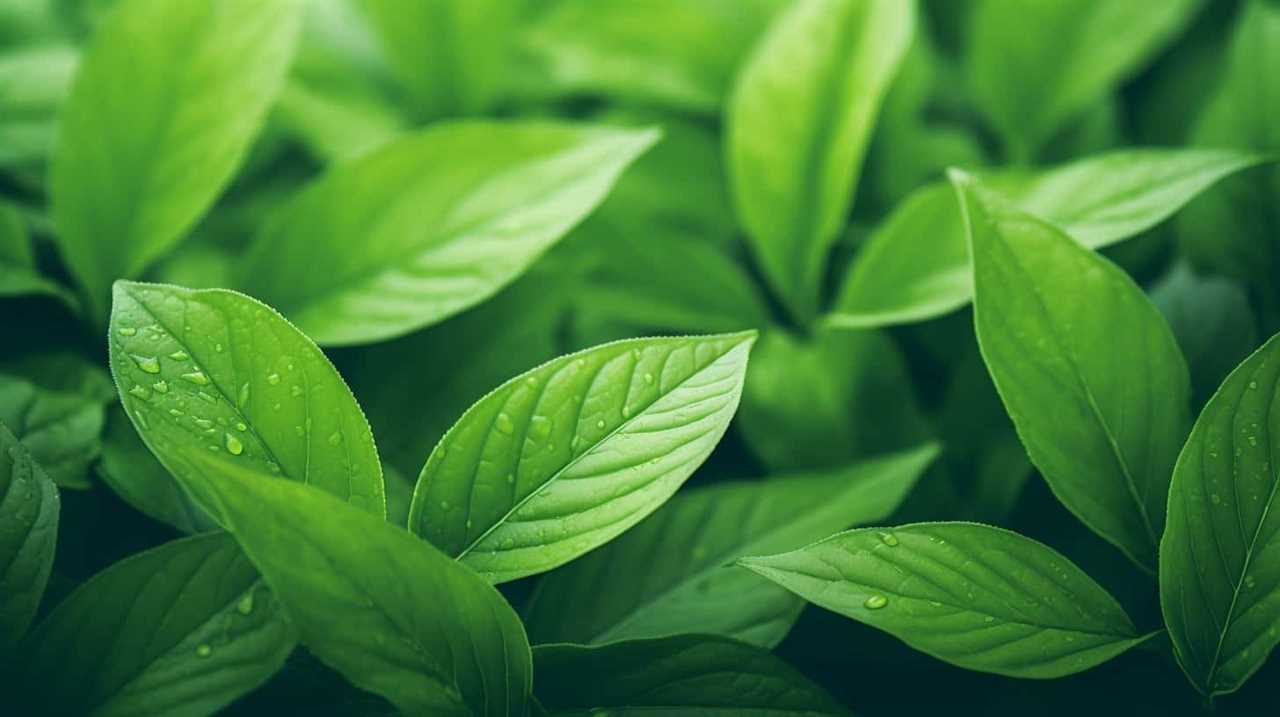
Growing Conditions’ Impact
The quality of matcha is greatly influenced by the growing conditions it’s cultivated in. The processing techniques impact and environmental factors’ influence play a crucial role in shaping the taste and aroma of matcha. Here are three key factors that evoke emotion in the audience:
- Soil composition: The minerals and nutrients present in the soil where the tea plants are grown directly affect the flavor profile of matcha. Rich, fertile soil enhances the natural sweetness and complexity of the tea leaves.
- Shade-grown cultivation: Matcha is known for its vibrant green color and umami taste, which are achieved through the practice of shading the tea plants during the final weeks before harvest. This technique increases chlorophyll production and reduces catechin levels, resulting in a smoother, less bitter flavor.
- Harvesting time: The timing of the harvest greatly impacts the taste of matcha. Younger leaves, picked early in the spring, tend to have a sweeter and more delicate flavor compared to leaves harvested later in the season.
Understanding the impact of these growing conditions is essential to appreciating the nuances of matcha. Now, let’s delve into how processing techniques further influence its taste.
Processing Techniques’ Influence
Continuing to explore the factors that shape matcha’s taste, we must now delve into the influence of processing techniques.
The way matcha is processed greatly affects its flavor profile. One key aspect is the growing methods employed for the tea leaves. Matcha made from shade-grown tea leaves tends to have a sweeter and more umami taste, while matcha made from sun-grown tea leaves can have a more bitter and astringent flavor. The shading process stimulates the production of amino acids, such as L-Theanine, which contribute to the savory taste.
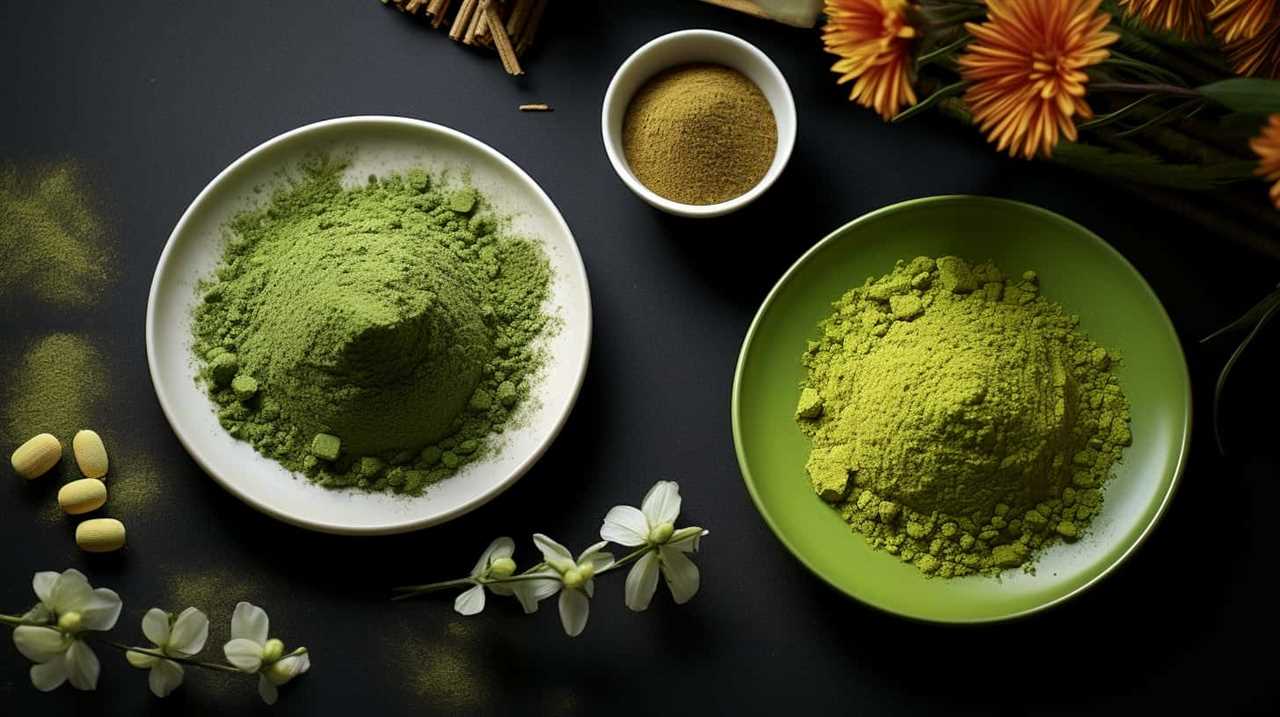
Another factor is the method of grinding the tea leaves into a fine powder. Traditionally, matcha is ground using granite stone mills, which preserves the integrity of the leaves and results in a smoother, richer flavor. In contrast, machine grinding may produce a more coarse texture and alter the taste.
Understanding the processing techniques is essential for those seeking mastery of matcha’s taste.
The Role of Chlorophyll in Matcha’s Flavor
To understand the flavor of matcha, it’s essential to explore the role that chlorophyll plays in enhancing its taste. Chlorophyll, the green pigment found in plants, is responsible for the vibrant color of matcha. It not only contributes to the visual appeal of the tea but also influences its flavor profile.
Here are three key factors that influence chlorophyll’s presence in matcha:
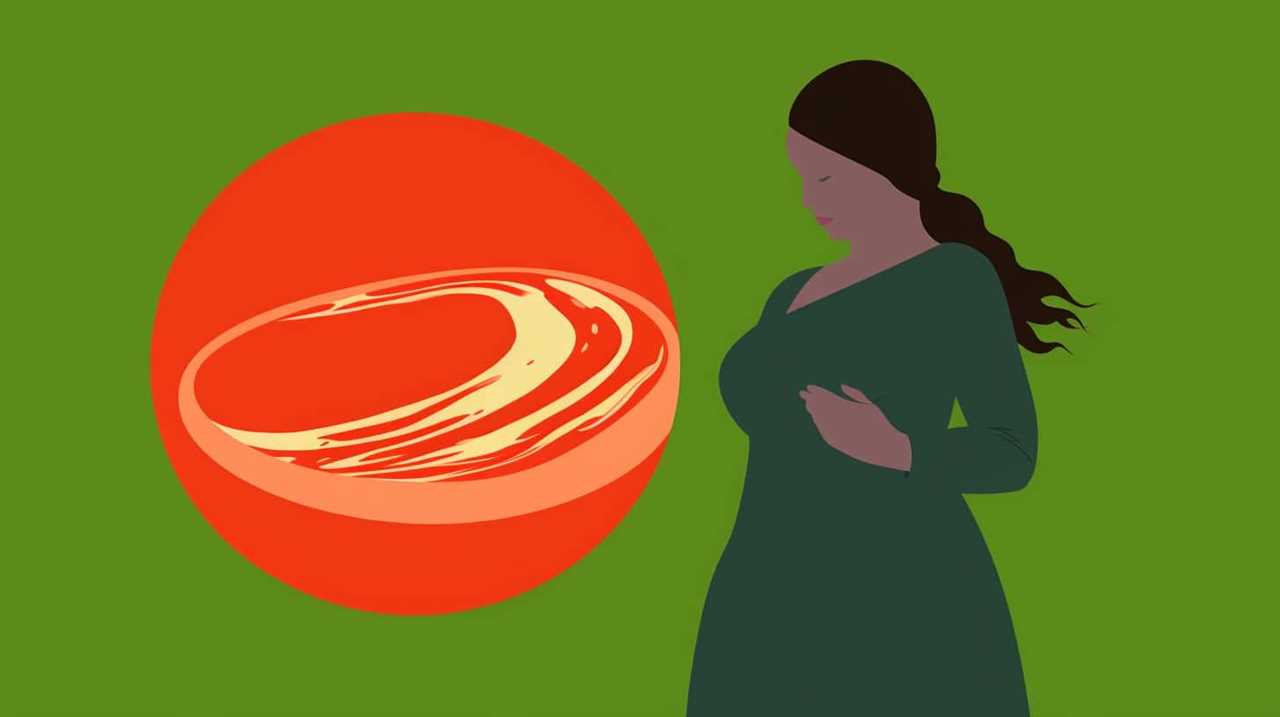
- Growing conditions: Matcha plants thrive in shaded environments, which stimulate the production of chlorophyll. Different growing conditions, such as the amount of sunlight, temperature, and soil composition, can affect the chlorophyll content in matcha.
- Harvesting time: The timing of the harvest also impacts the chlorophyll content. Young leaves, typically harvested in the spring, contain higher levels of chlorophyll, resulting in a more intense green color and a distinct flavor profile.
- Processing techniques: The processing techniques used to transform the harvested leaves into matcha can affect the chlorophyll content. Careful handling and minimal oxidation help preserve the chlorophyll and its associated flavors.
Understanding these factors gives us insight into the complex interplay between chlorophyll and matcha’s flavor, allowing us to appreciate the unique taste of this vibrant green tea.
Umami in Matcha and Seaweed
Umami, often described as a savory and rich taste, is a common characteristic found in both matcha and seaweed. These two ingredients share similar flavor profiles that are attributed to their high levels of amino acids, such as glutamate.
The presence of umami in matcha and seaweed not only enhances their taste but also makes them versatile ingredients in culinary applications, adding depth and complexity to a variety of dishes.
Similar Flavor Profiles
Our experience with matcha and seaweed’s similar flavor profiles has been intriguing. Exploring different flavor profiles and the influence of umami has allowed us to uncover a connection between these two ingredients. Here are three reasons why their similarity is worth noting:
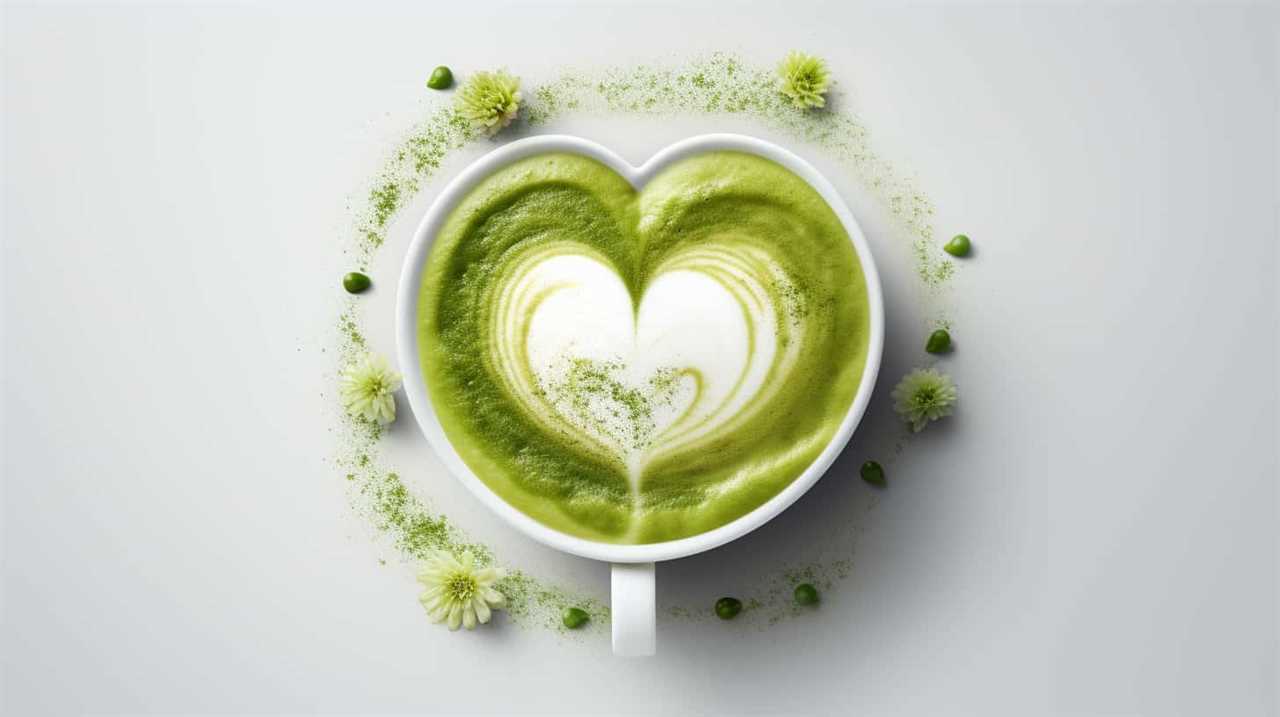
- Richness: Both matcha and seaweed possess a deep, earthy flavor that envelops the palate, leaving a lingering sensation of umami. This richness creates a sense of satisfaction and complexity in each bite or sip.
- Salinity: Seaweed’s natural saltiness is mirrored in matcha, adding a subtle savory note that enhances the overall taste. This shared salinity contributes to the umami experience and balances the other flavors present.
- Freshness: Whether it’s the vibrant green color of matcha or the vibrant hues of seaweed, both ingredients offer a refreshing and invigorating taste. This freshness awakens the senses and adds a rejuvenating element to any dish or beverage.
These shared flavor profiles between matcha and seaweed provide a foundation for further exploration into the umami-rich ingredients comparison.
Umami-Rich Ingredients Comparison
In our exploration of matcha and seaweed’s similar flavor profiles, we’ve discovered the rich umami present in both ingredients. Umami is a savory taste that adds depth and complexity to dishes, and it’s highly valued in Asian cuisine.
Seaweed, often used in Japanese cuisine, is known for its umami-rich flavor. When cooked, seaweed releases compounds that create a unique taste sensation on the palate.
Matcha, a powdered green tea, also possesses a distinct umami flavor. The umami in matcha comes from the amino acid L-theanine, which gives it a savory, slightly seaweed-like taste. This umami-rich ingredient is what sets matcha apart from other teas and contributes to its popularity in traditional Japanese tea ceremonies.
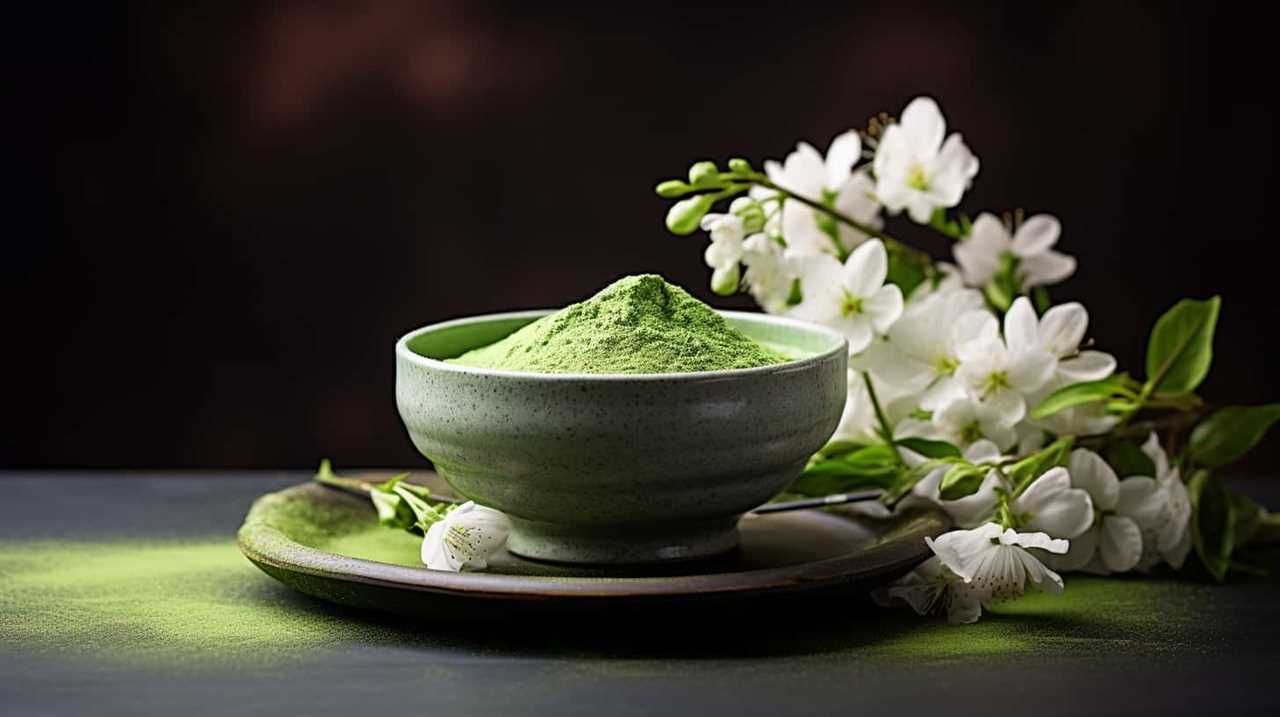
Culinary Uses of Umami
We can explore the culinary uses of umami found in both matcha and seaweed. Umami, known as the fifth taste, plays a crucial role in enhancing flavors in various cuisines. Here are three exciting ways umami is utilized in different culinary traditions:
- Japanese Cuisine: Matcha, a powdered green tea with a distinct umami flavor, isn’t only enjoyed as a beverage but also used in cooking. It adds a unique umami depth to dishes like matcha-flavored desserts, noodles, and savory sauces.
- Korean Cuisine: Seaweed, a staple ingredient in Korean cooking, is a rich source of umami. It’s commonly used in dishes such as seaweed soup, kimchi, and rice rolls, adding a savory and oceanic taste.
- Italian Cuisine: Parmesan cheese, a beloved ingredient in Italian cuisine, contains high levels of umami. It’s grated over pasta dishes, risotto, and salads, intensifying the flavors and creating a delightful umami experience.
The Health Benefits of Matcha and Seaweed
Let’s explore the health benefits of matcha and seaweed.
Matcha, a finely ground powder made from green tea leaves, is known for its high concentration of antioxidants. These antioxidants, called catechins, help protect the body against free radicals and reduce the risk of chronic diseases such as heart disease and cancer. Matcha also contains caffeine, which can boost energy levels and enhance mental focus.
Seaweed, on the other hand, is a nutritional powerhouse. It’s rich in vitamins, minerals, and fiber, making it a great addition to a balanced diet. Seaweed is also a good source of iodine, which is essential for thyroid function.

Now, let’s delve into the traditional uses of matcha in Japanese cuisine.
Traditional Uses of Matcha in Japanese Cuisine
As we explore the traditional uses of matcha in Japanese cuisine, we discover its versatile and distinctive flavor that adds a unique touch to various dishes. Matcha isn’t only used for making the popular matcha tea, but it’s also a key ingredient in many traditional matcha desserts.
These desserts, such as matcha ice cream and matcha mochi, showcase the vibrant green color and rich, earthy flavor of matcha. They aren’t only delicious but also provide the health benefits of matcha, including its high antioxidant content and potential metabolism-boosting effects.
Additionally, matcha is used in savory dishes like matcha soba noodles and matcha-flavored tofu, where it adds a subtle, yet complex taste to the overall dish. The traditional uses of matcha in Japanese cuisine truly highlight its culinary versatility and its ability to elevate the flavors of various dishes.

Seaweed’s Culinary Significance in Japan
When it comes to Japanese cuisine, seaweed holds a significant place in both tradition and flavor. Its versatility is evident in the various dishes it’s used in, from sushi rolls to miso soup.
But what truly sets seaweed apart is its distinct umami flavor, which adds depth and richness to countless Japanese dishes. From the delicate nori used to wrap sushi to the robust kombu used to make dashi broth, seaweed is an essential ingredient that brings a unique taste to Japanese cuisine.
Versatility in Japanese Cuisine
In Japanese cuisine, seaweed plays a vital role due to its versatility and wide range of culinary applications. It isn’t only used as a garnish but also as a main ingredient in various dishes. Here are three reasons why seaweed is essential in Japanese cooking:
- Umami Powerhouse: Seaweed has a rich and savory taste that enhances the flavors of other ingredients. It adds a unique depth and complexity to dishes, making them more delicious and satisfying.
- Nutritional Superfood: Seaweed is packed with vitamins, minerals, and antioxidants. It’s low in calories and high in fiber, making it a nutritious addition to any meal. It’s also a great source of iodine, which is essential for a healthy thyroid function.
- Culinary Versatility: Seaweed can be used in various forms, such as nori sheets for sushi, kombu for broths, and wakame for salads. Its versatility allows it to be incorporated into a wide range of dishes, from traditional Japanese cuisine to modern fusion creations.
Traditional Umami Flavor
Seaweed’s culinary significance in Japan lies in its traditional umami flavor. This unique flavor is a result of the growing techniques used to cultivate seaweed, as well as the way it is incorporated into various dishes. In Japanese cuisine, seaweed is not just a garnish or an afterthought; it is a key ingredient that adds depth and complexity to dishes. The umami flavor of seaweed is often described as a combination of savory, earthy, and slightly salty notes. It enhances the taste of other ingredients and creates a harmonious balance of flavors. To give you a glimpse of the culinary significance of seaweed in Japan, here is a table showcasing some popular dishes and the unique flavor combinations they offer:

| Dish | Unique Flavor Combinations |
|---|---|
| Miso Soup | Seaweed, tofu, and fermented soybean paste |
| Sushi | Seaweed, rice, and fresh seafood |
| Tempura | Seaweed, crispy battered vegetables, and a tangy dipping sauce |
| Seaweed Salad | Seaweed, sesame seeds, and a tangy vinaigrette |
| Onigiri | Seaweed, rice, and a variety of fillings such as pickled plum or grilled fish |
Through these dishes, seaweed’s traditional umami flavor shines, creating a culinary experience that is both satisfying and memorable.
How to Prepare Matcha Tea
How do we properly prepare matcha tea? Here are three essential steps to brew the perfect cup of matcha:
- Start with the right matcha tea: There are different types of matcha tea, ranging from ceremonial grade to culinary grade. Ceremonial grade matcha is the highest quality and is best enjoyed on its own. Culinary grade matcha is more suitable for cooking and blending.
- Use the right tools: To prepare matcha, you’ll need a bamboo whisk (chasen), a bamboo scoop (chashaku), a ceramic bowl (chawan), and a fine-mesh sieve (furui).
- Follow the best brewing method: Begin by sifting the matcha powder to remove any lumps. Then, add a small amount of hot water and whisk vigorously in a zigzag motion until a frothy layer forms on top. Finally, slowly pour hot water into the bowl and continue whisking until fully combined.
Pairing Matcha With Seaweed-Inspired Dishes
We love pairing matcha with seaweed-inspired dishes. One of our favorite ways to enjoy this combination is by pairing matcha with sushi. The earthy and umami flavors of matcha complement the flavors of seaweed-wrapped sushi rolls beautifully. The bitterness of matcha helps balance the richness of the fish and the saltiness of the soy sauce, creating a harmonious and well-rounded flavor profile.
In addition to pairing matcha with sushi, another creative way to incorporate seaweed into matcha is by making seaweed-infused matcha desserts. The subtle brininess of seaweed adds a unique twist to traditional matcha desserts like matcha ice cream or matcha cookies. By infusing the matcha with seaweed, you can create a delightful blend of flavors that’s both refreshing and intriguing.

The Cultural Significance of Matcha in Japan
Matcha holds a deep cultural significance in Japan, as it’s a cherished and integral part of traditional Japanese tea ceremonies. These tea ceremonies have been practiced for centuries and are rooted in Zen Buddhism, highlighting the importance of mindfulness and tranquility.
The cultural significance of matcha can be seen in its preparation, which involves precise movements and attention to detail. The health benefits of matcha also contribute to its cultural significance. Matcha is rich in antioxidants, vitamins, and minerals, making it a popular choice for those seeking a natural and healthy beverage. It’s believed to boost metabolism, improve focus, and provide a calming effect.
The combination of its cultural significance and health benefits makes matcha a truly unique and revered drink in Japan.
Exploring Matcha’s Growing Popularity in the West
As we delve into the rising popularity of matcha in the West, it becomes evident that its distinct flavor, reminiscent of seaweed, has captivated the taste buds of many.
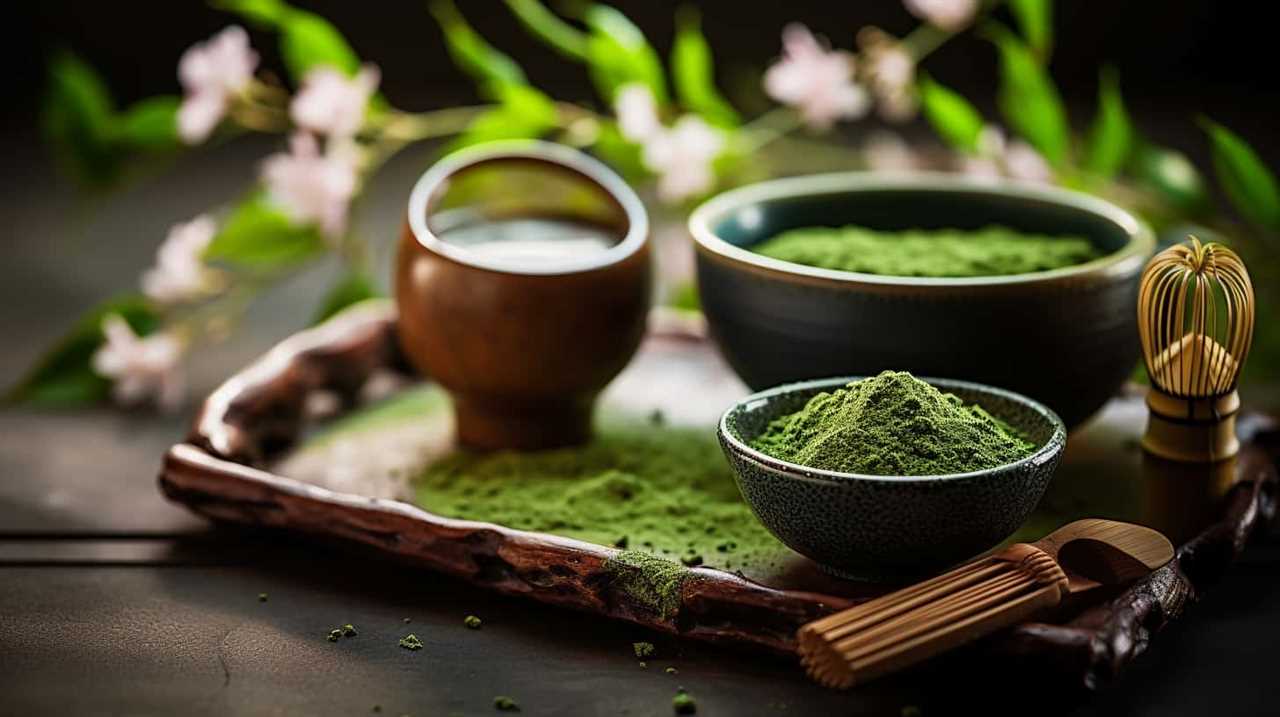
Matcha, a powdered green tea, has seen a surge in popularity in recent years, becoming a prominent ingredient in culinary trends and a favorite among health-conscious individuals. Its vibrant green color and earthy taste have found their way into a variety of dishes, from lattes and smoothies to desserts and savory dishes.
Matcha’s popularity can be attributed not only to its unique flavor but also to its numerous health benefits. Packed with antioxidants, matcha is known to boost metabolism, enhance focus, and promote relaxation. Additionally, its high concentration of chlorophyll provides detoxifying properties.
As the West continues to embrace matcha, its culinary versatility and health benefits are sure to keep it in the spotlight.
Matcha Vs. Seaweed: Which Flavor Is for You?
When exploring the flavors of matcha and seaweed, one can compare and contrast their unique tastes. Matcha tea vs. coffee: which is better for your taste buds? Here are some factors to consider:
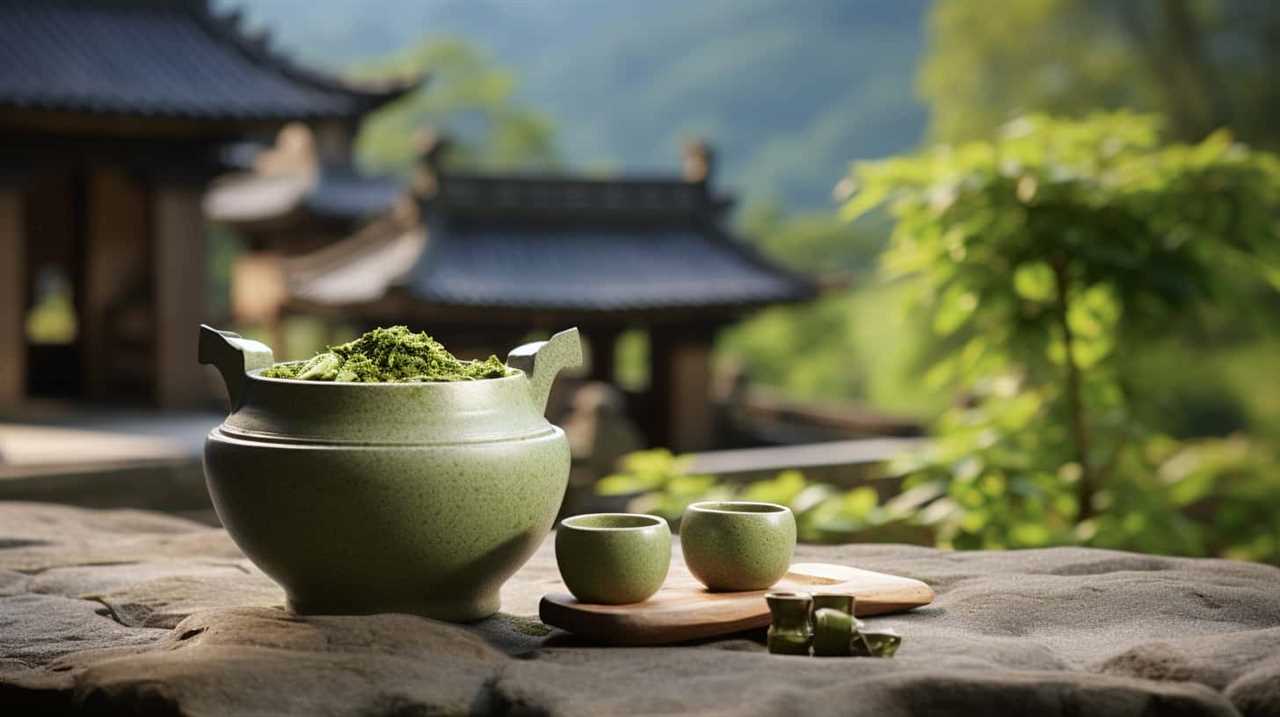
- Matcha tea: With its vibrant green color and earthy flavor, matcha tea offers a rich and subtly sweet taste. Its smooth and creamy texture adds to the overall experience, making it a popular choice for those seeking a delicious and calming beverage.
- Seaweed: On the other hand, seaweed has a distinct umami flavor that can be an acquired taste. Some describe it as savory and briny, while others may find it reminiscent of the ocean. Seaweed is often used in sushi and other Asian dishes, adding a unique and refreshing element to the overall flavor profile.
Matcha flavored desserts: a sweet treat or a seaweed nightmare? This depends on personal preference. While some may enjoy the delicate balance of sweetness and earthiness in matcha-flavored desserts, others may find the hint of seaweed flavor off-putting. Ultimately, the choice between matcha and seaweed comes down to individual taste preferences and culinary adventures.
Frequently Asked Questions
Can Matcha Tea Be Made From Any Type of Tea Leaves, or Are There Specific Leaves That Must Be Used?
Different types of tea leaves can be used to make matcha, but there are specific leaves that are most suitable. Matcha, known for its health benefits, is made from shade-grown tea leaves that are finely ground into a vibrant green powder.
Are There Different Grades of Matcha Tea, and if So, How Does the Grade Affect the Taste?
Different grades of matcha tea can greatly affect its taste. From ceremonial grade to culinary grade, each grade offers a unique flavor profile. Let’s explore the health benefits, popular recipes, and drinks that can be made with matcha.
Can Matcha Tea Be Used in Cooking, or Is It Primarily Consumed as a Beverage?
Matcha tea can be used in cooking, not just as a beverage. It adds a unique, earthy flavor to desserts and can be incorporated into creative matcha recipes. The possibilities are endless with matcha!
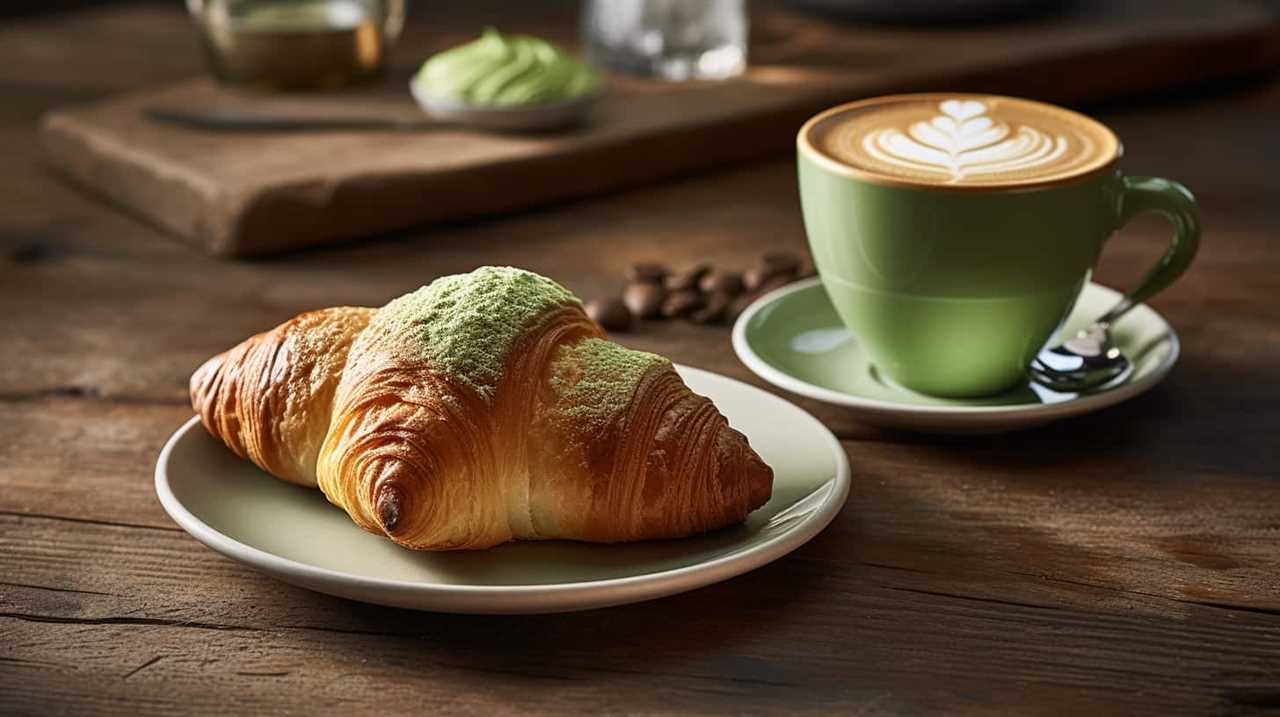
How Does the Process of Matcha Cultivation and Production Impact Its Flavor?
The process of matcha cultivation and production greatly impacts its flavor. Factors such as shading, harvesting, and stone grinding all contribute to the unique taste profile of matcha. For example, shading enhances the umami flavor.
Are There Any Potential Side Effects or Risks Associated With Consuming Matcha Tea or Seaweed?
There are potential side effects or risks associated with consuming matcha tea or seaweed. It’s important to consider the potential health benefits and recommended daily intake before incorporating these foods into your diet.
Conclusion
In conclusion, matcha tea and seaweed share a unique flavor profile that’s both earthy and savory. The similarities between these two ingredients make them a perfect pairing in seaweed-inspired dishes.
Matcha’s growing popularity in the West reflects its cultural significance in Japan, where it has been enjoyed for centuries.
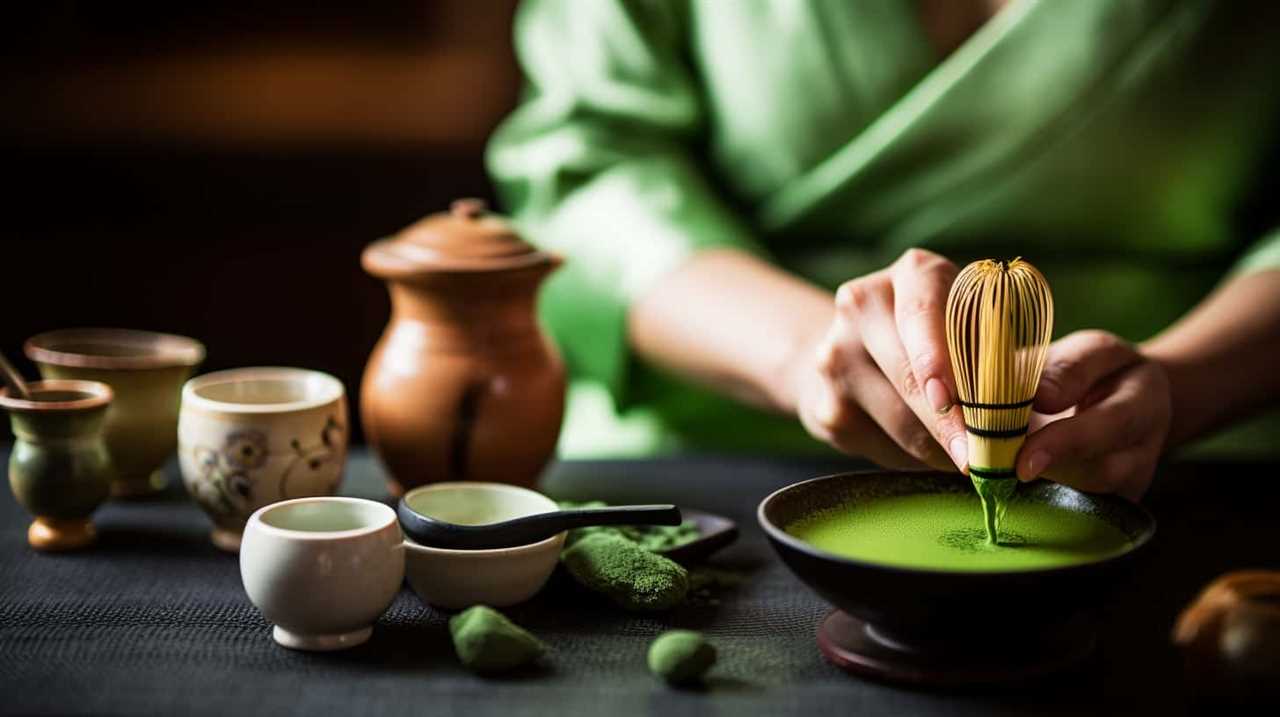
Whether you prefer the vibrant and energizing taste of matcha or the umami richness of seaweed, both flavors offer a delightful and distinct experience for your palate.
Justin is a seasoned author, coffee and tea enthusiast, and an essential member of the Cappuccino Oracle team. With a keen appreciation for the complexities of coffee, coffee alternatives, and tea, Justin has dedicated his professional career to exploring these realms and sharing his insights with readers worldwide.
Justin’s immersion in the world of coffee, coffee alternatives, and tea began at a young age, kindling a passion that extended beyond mere consumption. This love for these beverages led him to combine his talent for writing with his devotion to coffee and tea, bringing him to Cappuccino Oracle as a dedicated author.
Matcha
Unveiling The Mysteries Of Matcha: Insights On Its Origins, Production, And Quality

Have you ever been curious about the mysteries behind the rich and natural flavors of matcha? If so, get ready to join me on an adventure as we uncover the secrets of matcha, delving into its origins, production, and quality.
As a lover of all things tea, I have delved deep into the world of matcha, immersing myself in its rich history and intricate production process. From the shade-grown tea leaves to the meticulous grinding technique, every step is a labor of love that culminates in the velvety smooth powder we know as matcha.
Join me as we unravel the secrets behind this ancient Japanese tradition and discover why quality is key when indulging in this verdant elixir. We’ll explore the nuances of flavor, the importance of sourcing, and even delve into the fascinating world of other tea varieties.
So grab a cup, sit back, and let’s dive into the captivating world of matcha.
Key Takeaways
- Matcha tea is made from powdered green tea leaves and has a long and labor-intensive production process.
- Premium matcha is made from the first harvest in early spring, using the top 3 sprouts of the tea plant and ground tencha leaves.
- Cheaper matchas may skip some steps in the production process and are more suitable for matcha lattes.
- High-quality matcha is recommended for sparing consumption, as it has a smoother flavor and more health benefits compared to cheaper matchas.
What is matcha?
I’ve learned that matcha is a powdered green tea made from special tea leaves that are shaded before harvest, and it has a long and labor-intensive production process.
There are different types of matcha available, but the premium matcha is made from the first harvest in early spring, using only the top 3 sprouts of the tea plant. The leaves are then steamed, dried, and have their stems removed before being ground into a fine powder using a specialized mill made of granite.
It’s important to note that high-quality matcha is recommended for sparing consumption, as it has a complex production process that results in a smooth flavor. Matcha also offers various health benefits, such as being rich in antioxidants, boosting metabolism, and improving mental alertness.
Production process
The matcha production process involves shading the tea leaves before harvest and selecting the top three sprouts of the tea plant for premium matcha. Shading is a technique used to enhance the flavor and quality of the tea leaves. By covering the tea plants with shade, the leaves produce more chlorophyll and amino acids, resulting in a vibrant green color and a rich, umami taste.
After the shading period, only the top three sprouts of the tea plant are carefully handpicked for premium matcha. These selected leaves, known as tencha leaves, are then steamed, dried, and have their stems removed.
Finally, the tencha leaves are ground into a fine powder using a specialized granite mill. This process results in the smooth and concentrated matcha powder that we enjoy.
Quality and consumption
Let me tell you, indulging in high-quality matcha is like sipping a vibrant green elixir that awakens your taste buds and nourishes your body with its rich flavor and numerous health benefits. Matcha’s health benefits are truly remarkable. Packed with antioxidants, vitamins, and minerals, matcha is known to boost metabolism, enhance focus and concentration, and strengthen the immune system.
But not all matcha is created equal. Different grades of matcha exist, ranging from ceremonial grade to culinary grade. Ceremonial grade matcha is made from the highest quality tencha leaves and has a smooth, vibrant green color and a delicate, umami flavor. It is best enjoyed on its own, whisked with hot water.
On the other hand, culinary grade matcha is more affordable and is suitable for making matcha lattes, smoothies, and baked goods. Although it may have a slightly bitter taste and a duller color, it still provides health benefits.
So, whether you choose to indulge in high-quality ceremonial grade matcha or opt for the more affordable culinary grade, incorporating matcha into your routine is a delicious way to reap its health benefits.
Frequently Asked Questions
What are some popular ways to enjoy matcha besides drinking it as tea?
Besides drinking matcha as tea, some popular ways to enjoy it include indulging in matcha desserts like matcha ice cream, matcha cake, and matcha cookies. Additionally, matcha smoothies are a refreshing and healthy option.
Are there any specific health benefits associated with consuming matcha?
I’m no expert, but matcha is said to have potential health benefits. Some claim it can aid in weight loss due to its high antioxidant content and metabolism-boosting properties. However, more research is needed to confirm these claims.
How does the quality of matcha affect its flavor and overall experience?
The quality of matcha directly affects its flavor and overall experience. Higher quality matcha, made from carefully selected leaves and processed with precision, offers a smoother and more vibrant flavor, while lower quality matcha may have a less appealing taste and color.
Can matcha be used in cooking or baking?
"Where there’s matcha, there’s a way! Matcha can be used in a variety of cooking and baking recipes, adding a vibrant green color and a unique earthy flavor to dishes like matcha desserts."
Are there any specific tips or techniques for properly preparing matcha tea at home?
To properly prepare matcha tea at home, start by sifting the matcha powder to remove any clumps. Then, choose water at around 175°F to 180°F for the best flavor. Gradually add water to the matcha and whisk in a "W" or "M" motion until frothy. Enjoy!
Conclusion
In conclusion, matcha tea is not just a beverage, but a rich and fascinating tradition that has evolved over centuries.
From its origins in Japan to its intricate production process, matcha is a labor of love.
The quality of matcha is crucial, as the steps taken in its production directly impact its flavor and aroma.
Whether you’re a matcha connoisseur or a beginner, there is a matcha tea out there for you.
So, why not indulge in a cup of this vibrant green elixir and experience the magic of matcha for yourself? It’s a journey worth embarking on!
Arf, an author and an innovative enthusiast of coffee, coffee alternatives, and tea, plays a crucial role as a contributor to the esteemed Cappuccino Oracle platform. Renowned for his curiosity and passion for these captivating beverages, Arf has carved out a unique space for himself in the world of exploration and writing. He realized that coffee, coffee alternatives, and tea are not mere drinks to keep one awake, but universes of flavors and stories waiting to be explored.
Arf’s articles for Cappuccino Oracle blend meticulous research with personal experiences, providing readers with an in-depth understanding of various types of coffee, coffee alternatives, and tea, along with their unique characteristics, cultures, and histories. His honest reviews and engaging narratives guide readers on their own journeys, helping them discover their preferences and find their perfect brew.
Matcha
Unveiling The Truth Behind Starbucks’ Matcha: A Disappointing Blend

Being a lover of tea, I was eager to sample Starbucks’ matcha beverages, anticipating a flavorful and genuine taste. However, to my dismay, I found that it was a subpar mixture of inexpensive green tea powder and an excessive amount of sugar. This was a stark contrast to the customary matcha experience that I had grown accustomed to.
The use of low-quality matcha by Starbucks is driven by the need for mass production and a consistent taste across all locations. But in this pursuit, they have sacrificed the true essence of matcha. Authentic matcha production involves meticulous steps to ensure a high-quality and flavorful product, steps that Starbucks seems to skip.
The result is a matcha latte packed with 32 grams of sugar, equivalent to a can of soda, and a whopping 240 calories. It’s time to unveil the truth behind Starbucks’ matcha and explore better options for a truly satisfying tea experience.
Key Takeaways
- Starbucks uses a cheap green tea powder for their matcha drinks, which may not even be considered matcha.
- The cheap matcha powder is mixed with a lot of sugar, negating the health benefits and undermining the quality of the tea.
- Starbucks’ matcha latte contains a high amount of sugar, similar to a can of soda, and has a significant number of calories.
- To have a better matcha experience, it is recommended to explore premium, first harvest matcha made by talented farmers in Japan and to try different matcha options to find preferred taste.
What is Starbucks Matcha?
Starbucks Matcha is a cheap green tea powder mixed with a high amount of sugar, which not only undermines the health benefits of matcha but also fails to deliver the natural, great-tasting flavor of authentic matcha tea.
The ingredients used in Starbucks matcha include low-quality green tea powder that is likely produced on a large scale. Unlike traditional matcha production methods, Starbucks skips certain steps to save time and money. These steps, such as shading the tea plants to reduce bitterness and selecting the top leaves for their flavor and nutrients, are crucial in creating high-quality matcha.
Instead, Starbucks opts for a blend of cheap green tea powder mixed with sugar, resulting in a dull and bitter flavor. This disappointing blend of ingredients does not live up to the standards of true matcha tea.
Quality vs. Cheap Matcha
Indulging in high-quality matcha is like savoring a delicate melody that dances on your taste buds, while settling for cheap matcha is akin to a discordant symphony that leaves a bitter aftertaste. When it comes to matcha, quality matters. Traditional matcha production is an art that requires time, patience, and attention to detail. The importance of shading the tea plants, selecting the top leaves, and using a stone mill to grind the leaves into a fine powder cannot be overstated. These steps not only enhance the flavor but also preserve the health benefits of matcha. High-quality matcha is rich in antioxidants, boosts metabolism, and promotes a sense of calm. On the other hand, cheap matcha often lacks these qualities as it skips crucial steps and is mixed with sugar and other additives. Don’t settle for a subpar matcha experience; choose high-quality matcha for its exceptional taste and health benefits.
| Traditional Matcha Production |
|---|
| Shading the tea plants |
| Selecting the top leaves |
| Grinding with a stone mill |
The importance of traditional matcha production cannot be overstated. These steps not only enhance the flavor but also preserve the health benefits of matcha. High-quality matcha is rich in antioxidants, boosts metabolism, and promotes a sense of calm. On the other hand, cheap matcha often lacks these qualities as it skips crucial steps and is mixed with sugar and other additives. Don’t settle for a subpar matcha experience; choose high-quality matcha for its exceptional taste and health benefits.
Recommendations for Better Matcha
Exploring different matcha options can lead to a better matcha experience. When it comes to matcha, not all options are created equal. While Starbucks may offer a convenient matcha latte, there are alternative options that provide a more authentic and higher quality experience.
Premium matcha, specifically first harvest matcha, is made by talented farmers in Japan and can be enjoyed plain, without the need for excessive sugar or additives. By choosing premium matcha, you can reap the full benefits that matcha has to offer, such as its high antioxidant content and potential health benefits.
Additionally, exploring different types of matcha, such as Japanese black tea, can expand your taste palate and introduce you to new and exciting flavors. So, why settle for a disappointing blend when there are better matcha options out there waiting to be explored?
Frequently Asked Questions
How is Starbucks matcha different from traditional matcha?
Starbucks matcha differs from traditional matcha in terms of quality and taste. One interesting statistic is that Starbucks’ matcha latte contains 32 grams of sugar, similar to a can of soda, which undermines the health benefits of matcha.
What are the health benefits of matcha and how do they differ between Starbucks matcha and premium matcha?
The health benefits of matcha include high levels of antioxidants, increased energy, and improved focus. However, Starbucks matcha quality is compromised due to the use of cheap powder mixed with sugar, negating these benefits.
Can you customize the sweetness level of Starbucks matcha drinks?
Yes, you can customize the sweetness level of Starbucks matcha drinks. They offer popular matcha drink variations like matcha latte and matcha frappuccino, allowing customers to choose the amount of sweetener they prefer.
Are there any alternative options for matcha drinks at Starbucks?
Yes, there are alternative options for matcha drinks at Starbucks. However, it’s important to note that the taste may not be comparable to traditional matcha. Exploring different matcha options and Japanese black tea can provide a better experience.
What are the steps involved in producing high-quality matcha and how does Starbucks’ matcha production differ?
Starbucks’ matcha production process differs from traditional matcha production in Japan. High-quality matcha involves shading the tea plants, selecting the top leaves, steaming, drying, and grinding them. However, Starbucks skips these steps, resulting in a lower quality and less authentic matcha experience.
Conclusion
In conclusion, after delving into the truth behind Starbucks’ matcha, it’s clear that their blend falls short of expectations. The use of cheap green tea powder mixed with excessive sugar dilutes any potential health benefits and fails to deliver an authentic matcha experience.
To truly enjoy the rich and flavorful taste of matcha, it’s recommended to explore premium, first harvest options crafted by skilled Japanese farmers. Don’t settle for subpar matcha; treat yourself to a tea experience that’ll leave your taste buds dancing with delight.
Arf, an author and an innovative enthusiast of coffee, coffee alternatives, and tea, plays a crucial role as a contributor to the esteemed Cappuccino Oracle platform. Renowned for his curiosity and passion for these captivating beverages, Arf has carved out a unique space for himself in the world of exploration and writing. He realized that coffee, coffee alternatives, and tea are not mere drinks to keep one awake, but universes of flavors and stories waiting to be explored.
Arf’s articles for Cappuccino Oracle blend meticulous research with personal experiences, providing readers with an in-depth understanding of various types of coffee, coffee alternatives, and tea, along with their unique characteristics, cultures, and histories. His honest reviews and engaging narratives guide readers on their own journeys, helping them discover their preferences and find their perfect brew.
Matcha
The Ultimate Guide To Using Chashaku: Your Matcha Essential

Being a lover of matcha, I am aware that the crucial factor in achieving the perfect matcha bowl is the equipment we utilize. When it comes to preparing matcha, there is one tool that is particularly essential: the chashaku.
This bamboo spoon, with its elegant design and precise measurements, is the secret weapon of matcha lovers worldwide. In this ultimate guide, I will take you on a journey through the history and evolution of the chashaku, and show you how to use it like a pro.
From its origins as a metal or ivory scoop to its modern-day incarnation in bamboo, the chashaku has come a long way. With its 48° bend and 18mm length, it effortlessly scoops the perfect amount of matcha from its container.
So grab your chashaku and get ready to elevate your matcha game to new heights. Let’s dive in and discover the wonders of this matcha essential.
Key Takeaways
- Chashaku is a bamboo spoon used to scoop matcha powder in the Japanese tea ceremony and by matcha lovers worldwide.
- Chashaku is one of the three important tea utensils used in the tea ceremony and is about 18mm in length with a 48° bend at the end for scooping.
- Chashaku is made of bamboo to avoid negative reactions with matcha powder and is a great measurement tool for matcha powder.
- Two scoops of chashaku is the standard amount for a bowl of matcha tea, and it is easy to maneuver in matcha tins or natsume due to its small size.
What is Chashaku?
Chashaku is a bamboo spoon used to scoop matcha powder, and it’s one of the three important tea utensils used in the Japanese tea ceremony.
Made from a single piece of bamboo, this elegant tool has a long history dating back to the Muromachi period in Japan. Originally crafted from metal or ivory, chashaku evolved to be made of bamboo due to its natural properties and to avoid any negative reactions with matcha powder.
The design of chashaku is both functional and beautiful, with a length of about 18mm and a 48° bend at the end for easy scooping. There are different styles of chashaku scoops, each with its own unique shape and characteristics. The back of the chashaku has a rough texture, while the face is smooth and sleek.
Whether you’re a matcha lover or a tea ceremony enthusiast, using a chashaku adds a touch of authenticity and tradition to your matcha preparation.
History and Evolution
During the Muromachi period in Japan, the chashaku spoon evolved from being made of metal or ivory to its current bamboo form, which is about 18mm in length and has a 48° bend at the end for easier scooping. The history and evolution of the chashaku is a testament to its significance in Japanese tea ceremonies and its cultural importance in matcha preparation.
| The significance of chashaku in Japanese tea ceremonies | The cultural importance of chashaku in matcha preparation |
|---|---|
| Chashaku is one of the three important tea utensils used in the tea ceremony. | Chashaku is a great measurement tool for matcha powder. |
| Chashaku originated in Japan during the Muromachi period. | Chashaku’s small size allows for easy maneuvering in matcha tins or natsume. |
| Originally made of metal or ivory, chashaku evolved to be made of bamboo. | Chashaku is made from a single piece of bamboo and shaped with a bend for the scoop. |
| Chashaku is made of bamboo to avoid negative reactions with matcha powder. | The back of chashaku has a rough texture, while the face is smooth and sleek. |
The chashaku’s role in Japanese tea ceremonies cannot be understated. It is one of the three essential utensils used in the tea ceremony, alongside the chawan (tea bowl) and chasen (tea whisk). The chashaku’s small size and precise measurement make it the perfect tool for scooping matcha powder. Its evolution from metal or ivory to bamboo shows the cultural importance placed on this utensil. The chashaku’s design, with its gentle bend and smooth face, allows for easy and graceful scooping of matcha. Using the chashaku is not only practical but also a way to honor the centuries-old tradition of matcha preparation.
How to Use Chashaku
To use the chashaku, I simply hold it like a pencil and dip the scoop into the matcha container. Then, I carefully lift the chashaku scoop out and place it over the matcha bowl to dump the powder.
It’s a simple and elegant technique that ensures the perfect amount of matcha every time.
But did you know that there are alternative ways to use the chashaku? Some matcha lovers prefer to use a teaspoon or a regular spoon to scoop their matcha powder. While these alternatives may work in a pinch, they don’t offer the same precision and authenticity as the chashaku.
The chashaku’s unique design and size make it the ideal tool for measuring matcha powder. Plus, using the chashaku adds a traditional touch to the matcha preparation process, enhancing the overall experience.
So why settle for anything less? Embrace the chashaku and elevate your matcha game to the next level.
Frequently Asked Questions
What are the different types of materials used to make chashaku besides bamboo?
There’s something truly magical about the chashaku, the bamboo spoon that gracefully scoops matcha powder. While bamboo is the traditional material, chashaku can also be made from metal or ivory, although these alternatives are less common.
Can chashaku be used to scoop other powders besides matcha?
Yes, chashaku can be used to scoop other powders besides matcha. However, it is primarily designed for scooping matcha powder and is most commonly used in Japanese tea ceremonies. To properly clean and care for a chashaku, it is recommended to wipe it with a dry towel or tissue to avoid water damage. The chashaku is a versatile tool with different uses in the tea ceremony, making it an essential item for matcha lovers.
How long does a chashaku typically last before it needs to be replaced?
A chashaku typically lasts for a long time, but the lifespan can vary depending on the material. Bamboo chashaku is the most common and durable option, while metal or ivory may wear down over time. Proper care involves cleaning with a dry towel or tissue to avoid water damage.
Can chashaku be used with different types of matcha bowls or is it specific to a certain style?
Absolutely! Chashaku can be used with various types of matcha bowls, adapting to different styles. Its small size and unique design make it perfect for scooping matcha powder and adding a touch of elegance to your matcha preparation.
Are there any alternative utensils that can be used in place of chashaku for scooping matcha powder?
Yes, there are alternative utensils for scooping matcha powder, such as a teaspoon or a small spoon. However, using a chashaku has its benefits. Its unique design allows for precise measurements and easy maneuvering in matcha tins.
Conclusion
In conclusion, using chashaku isn’t just a practical way to measure and scoop matcha powder, but it’s also an essential tool for embracing the art and tradition of the Japanese tea ceremony.
While some may argue that using a regular spoon can achieve the same result, chashaku offers a unique experience that connects us to centuries of tea culture. Imagine holding the slender bamboo spoon, feeling the weight of tradition in your hand, and delicately scooping the vibrant green matcha powder.
It’s a sensory journey that brings us closer to the beauty and mindfulness of matcha preparation. So, embrace the chashaku, and let it elevate your matcha experience to new heights.
Arf, an author and an innovative enthusiast of coffee, coffee alternatives, and tea, plays a crucial role as a contributor to the esteemed Cappuccino Oracle platform. Renowned for his curiosity and passion for these captivating beverages, Arf has carved out a unique space for himself in the world of exploration and writing. He realized that coffee, coffee alternatives, and tea are not mere drinks to keep one awake, but universes of flavors and stories waiting to be explored.
Arf’s articles for Cappuccino Oracle blend meticulous research with personal experiences, providing readers with an in-depth understanding of various types of coffee, coffee alternatives, and tea, along with their unique characteristics, cultures, and histories. His honest reviews and engaging narratives guide readers on their own journeys, helping them discover their preferences and find their perfect brew.
-

 Americano3 weeks ago
Americano3 weeks agoHow to Make Americano With Moka Pot
-

 Americano1 week ago
Americano1 week agoHow to Make Korean Iced Americano
-

 Americano4 weeks ago
Americano4 weeks agoHow to Make an Americano in a French Press
-

 Americano3 weeks ago
Americano3 weeks agoHow to Make Iced Americano With Instant Coffee
-

 Americano4 weeks ago
Americano4 weeks agoWhat to Add to an Americano at Starbucks
-

 Americano4 weeks ago
Americano4 weeks agoHow to Make Americano With a Nespresso Machine
-

 Americano3 weeks ago
Americano3 weeks agoHow to Make Americano With Bialetti
-

 Americano3 weeks ago
Americano3 weeks agoHow to Make Dutch Bros Americano

















